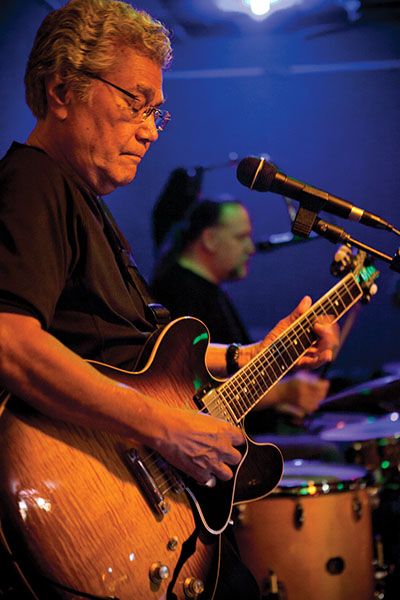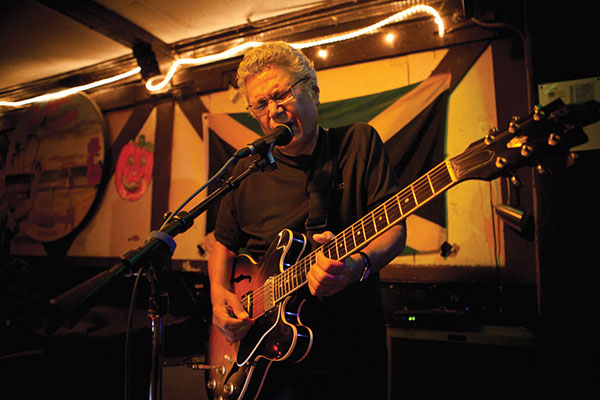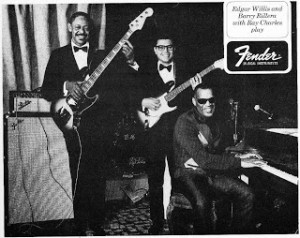
Barry Rillera has been jamming on R&B for decades, with connections to The Beatles, Ray Charles, The Righteous Brothers and many others.
Now, Barry is working on recording his second album and we're thrilled that he took the time to answer some questions about his storied career.

RW – Glad to catch up with you Barry - What have you been up to musically these days?
BR – Thanks for asking, I'm grateful that people might still be interested. Just started working on my second album which I'm excited about because of the material I've put together. That's what prompted me to take on another solo project.
There are 13 tracks - I've written 12 - and I'm doing a remake of an old 40's instrumental ballad which I've loved since I first heard it back in the 50's.
I still play play live, but not as much - I work with my classic rock, 4-piece group, the first weekend of the month, and I still play every Sunday night with some friends of mine in Laguna. I also do the occasional casual. Info is on my website at www.BarryRillera.com
RW – Tell us about the recording of your album From Where I Stand?
BR – That was my first attempt at a solo project, in which I wrote all the tunes except one. My good friend (and percussionist), Richard Torres, encouraged me to do this in his studio, and he also produced, recorded and mixed the album, for which I am extremely grateful. He guided me through the process and I learned quite a bit about being on this end of it. On this album I wanted to give a look at some of the different styles of music that influenced me and shaped my tastes.
RW – What are your earliest memories of music?
BR – Actually my older sister and brother were into R&B from early high school age on. I remember riding in my brother's car, listening to Ole H.H., Hunter Hancock, who had a daily radio show from L.A., and featured popular R&B hits of the time. The energy and awe I experienced made me a huge fan of R&B, which in those days, R&B & pure blues were thought of as one and the same - including singers such as Dinah Washington, Pee Wee Crayton, Lowell Fulsom, and vocal groups like The Platters and The Drifters, from which many solo artists emerged. And of course - my first encounter with B.B. King!, who instantly became my musical hero.
RW - I know you come from a musical family, how has this shaped you as a songwriter and musician?
BR – I'm half Filipino (Dad) and half Mexican (Mom) by the way, and I've always felt that my cultural background has had an important effect on me as far as broadening and shaping my musical tastes. My Dad, my personal hero in life, loved music and always had a piano at home, which he used to relax with when he came home from work, picking out tunes by ear (complete with chords) from the latest tunes on the radio's Hit Parade. Every so often he would take our family up to L.A. to a movie theater (Orpheum?) that would have live big bands during the intermission (Lionel Hampton for example). Again the influence of the popular black orchestra leaders was quite exciting with their tuxedoed musicians putting out great energy as one driving unit. This and the smaller R&B groups we heard on 78 records on the radio, was to become a deep influence, although I didn't realize it at the time.
RW - Do you have any special stories that you would like to share about touring and recording with Ray Charles?

BR – Being around Ray was an incredible experience in itself. Whatever he wanted to do or learn, he would do it, whether it was musical, or anything that piqued his curiosity. I remember him on the road with his chessboard, challenging any and all orchestra members to play him on the bus or plane (which no one ever beat him of course!). I was told that he had a Piper Cub that they would take him up in, so he could fly it around. On his jet, which we travelled in, once we took off he would head for the cockpit. Whenever the door would open you could see him sitting next to the pilot and carrying on a conversation, totally involved and flipping switches every so often. He also had a motorbike he enjoyed driving, so they would take him to big, empty lots to do this.
My late brother-in-law played lead trumpet in Ray's orchestra (he also played with Stan Kenton and Gene Krupa amongst others). He told me Ray was auditioning guitar players for an upcoming European tour. So mostly out of curiosity, I eventually got an appointment to audition at Ray's recording studio above his L.A. office building. When I got there I wasn't sure what was going on because his people told me to set up, but there were no other musicians around, or anyone there at all. After I set up, in walks Ray alone. He sat down at the piano and asked me what I wanted to play, so I said "how about some blues"? After a bit he showed me a chorded lick he liked that he wanted me to play, which I was kinda familiar with, thank God. He asked me what else I wanted to play, so I suggested "Moonlight In Vermont" and we jammed some more and that was it. Needless to say I was in awe the whole time!
By the way, Billy Preston did the opening for the tour with Ray's orchestra, then he would go up in back and play along on B-3. Also Mary Clayton was one of the Raelettes at that time. Sometime later the orchestra was called to do a session at his studio, with a string section added and Marty Paich conducting an arrangement he had done for Ray. But what really threw me was looking into the booth and seeing Ray at the console, a secretary taking notes from Ray and a band boy moving mics in and out, etc., according to Ray's instructions. No one else! I could go on and on about amazing things he would do that eventually didn't surprise me.
RW - Same question with The Righteous Brothers?
BR - I did a lot of traveling with the brothers and played in many special venues, playing at The White House for Clinton's Georgetown reunion, doing the Beatles first American Tour, and doing concerts with some of the greatest R&B acts ever. One thing for certain though, was that the Righteous Brothers and myself all idolized Ray. When I told Bill & Bob that I had chance to play with Ray, their reaction was great! They told me to go ahead and do it, and when I was done, I could come back and continue touring with them.
RW - You mention that BB King was one of your inspirations, what inspires you most about his playing and who were some other influences?
BR - I think B.B. was so important and special to me because he was the first electric blues player I became entranced with. His feeling, his sound, and simplicity (if you will) just came across to me so strong emotionally. On the album I'm working on there's a tune I wrote called Epiphany, which is about the Rillera Brothers musical history, and of course the enlightening I got from first hearing B.B. King.
By the way, it wasn't until sometime after I got into R&B that a friend of my parents commented that our records were called "race records" which in my naivete I really didn't get the meaning of, but which mattered very little, because me and my older brother Ric (upright bass at the time) were so into this music. I spent a lot of my early guitar learning days listening to B. B.'s 78's, trying to get his style and feeling into my playing. I've always felt there was B.B., and then everything electric guitar after that, whether it was blues, rock or whatever, to me B.B. started it all - but I'm partial and credit so much of his influence on me that I can only see it that way. I never really got into acoustic or steel-body guitar blues, the electricity driving the power of electric guitar was what fascinated me.
RW - I heard that you inspired the song Louie Louie, please elaborate.
BR - My brother's band which was called The Rhythm Rockers, played R&B and latino-styled dance music, which started getting us bookings outside of Orange County for black crowds in L.A. At these dances we used to back up guest star vocal groups that had hits at the time (The Robins, Penguins, Rivingtons, Coasters, etc.). One dance we did for a black social club in LA. booked Richard Berry as special guest. We immediately hit it off with him and my brother asked Richard if he would come down to these Sunday night dances we were doing in Anaheim. Richard, a singer and piano player, would do a few tunes each set as our special guest artist. While he was waiting to go on, he would just sit backstage and listen. He was very much into music and worked as a songwriter on a weekly salary for a record label in L.A. He was quiet, soft spoken and a gentleman at all times, very much interested in the kinds of music we were playing.
Little did we know that he was analyzing our R & B interpretations as well as the Latino rhythms we did. One night he told my brother he was working on a tune that was influenced by one of the Cha-Cha's we used to play. He asked about it and Ric told him it was called "El Loco Cha Cha" by a popular Cuban bandleader named Rene Touzet. The intro to this song was just rhythm section (piano, bass, timbales, congas) with the signature, infectious "Louie Louie" piano/bass line which caught Richard's attention. When he finished the song and recorded it, he brought a 45 copy for us to hear, but it sounded nothing like the later huge hit versions of it. It was a mellow, soulful, Calypso styled song that had his soulful electric piano driving it, and we loved it.
RW - It has been said that you taught guitar technique to The Beatles. Please share!
BR -Partially true, not guitar technique so much but a little known fact at the time. The first Beatles U.S. tour had as openers the Bill Black Combo, the Exciters vocal group, the Righteous Brothers (who had brought me along to kinda direct the back-up combo), and Jackie DeShannon (in that order).
There were speakers in all the dressing rooms and The Beatles would hear all the opening acts. They noticed one guitar had this twangy effect. They thought it was Bill Black's guitar player (a great guitarist and Nashville studio regular named Reggie Young), so they went to them and were told it was the Righteous Brother's guitar player. Next thing I know Paul McCartney comes to the rear of the plane one day, where all the opening acts were sitting, and sat down next to me. He started asking me how I got that sound. I told him it was from using thin gauge strings that bent easily. At the time, George was using regular gauges which were fairly thick & didn't bend easily. Thin gauge strings were not readily available, but one of my musician friends found out that supposedly Glen Campbell was using banjo strings on the top end. Glen had just come to L.A. and was getting known as a studio guitarist at the time.
By the way, I had a nice talk with Paul and asked several questions about their songwriting patterns and techniques. It turned out that they actually didn't really follow any set procedures. He said sometimes John might bring some lyric ideas to him and vice versa, or Paul might have a chord sequence he'd take to John - in other words, just whatever idea struck them - a partial melody line, etc., and they would both contribute and build from there. They might also go to George with similar thoughts to work on. Paul was a very nice person, quite open and friendly.
RW - You and your brothers were the first rock band to play Disneyland - what was that like?
BR - Wow, I was going to Long Beach State at this time and it was so much fun, getting paid to play in that setting and meeting people from all over. Many young people from out of state would come there to work for the summer, and there were parties every night after work hours. Many times you'd find parties posted on bulletin boards at the break areas.
Our boss and bandleader, Sonny Anderson, decided the time was right for a R&B band to cater to a younger crowd. Someone told Sonny about my brother Ric (switched to Fender by then), he told Sonny about me, and we told him about our younger brother Butch, a singer and drummer. Sonny let us choose just about any songs we wanted to do as long as it fit with the dance theme he had put the band together for - to draw the younger crowds to our stage.
We would play our favorite R&B songs and surf music was becoming very popular, so we did some of that also and mixed it all in. It instantly became very popular with tourists and young people alike. It became a favorite weekly hang-out for young dancers who had never seen a band playing rock at Disneyland. Sonny always had at least two horns with the band and a female lead singer, and eventually he added a couple more horns, so it introduced horn sections to people who were used to the smaller combos that were popular at the time. People would tell me they loved this different brand of music and were influenced by it.
RW - For the musicians reading - What are some of your main equipment choices that give you your tone?
BR - I'm old school and I've always been partial to the tube amp sound. Pat Quilter at Quilter Sound is working on a transistorized tubeless amp that he let me try and he's very close to getting that sound. I'm sure he will. I've gone through numerous pedal choices, but for awhile now I've been using a stereo chorus split into 2 Fender amps along with a boost pedal called a Zendrive, the simplest pedal this company makes. Personally these combinations work for me, but I've heard many guitarists get great sounds using any number of combinations of amps, pedals and guitars. My main guitar is a Gibson 335.
RW - Where can we see you play these days?
BR - I've cut down on my gigs and devote most of my time to the album I'm working on. I still play every Sunday night at The Sandpiper in Laguna with some longtime friends. I also play the first Friday of the month with my 4-piece group that plays what I would call classic rock - recognizable hits from past years chosen with our dancers in mind. Once again, for additional info please go to: www.BarryRillera.com